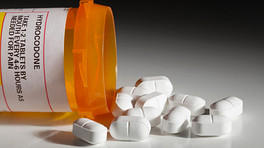Getting the right medication to relieve breakthrough pain is a balancing act.
Since breakthrough pain can reach its peak in 5 minutes or less, the medication has to take effect quickly. On the other hand, the pain typically dissipates within an hour, so a long-lasting pain medication could result in treatment continuing when it is no longer needed. 1 Smith HS. Considerations in selecting rapid-onset opioids for the management of breakthrough pain. J Pain Res. 2013;6:189-200.
Another factor to consider is overmedication when breakthrough pain medication is added; by definition, breakthrough pain affects people already taking narcotic medication 24 hours a day.
In This Article:
- Understanding Breakthrough Pain
- Medications for Breakthrough Pain
- Common Risks and Side Effects of Treating Breakthrough Pain
- Managing Breakthrough Pain
Long- and Short-Acting Narcotics
Narcotic medications vary in how quickly they reach full strength and how long the effect lasts.
People experiencing breakthrough pain are typically prescribed long-acting narcotic medications on a scheduled basis to offer continuous relief of chronic pain. Due to their slow onset and long duration, these medications are usually not well-suited to the urgent—but short-term—need for breakthrough pain relief.
Short-acting narcotics, sometimes called immediate-release narcotics, take effect more quickly—in 30 minutes to an hour—and their effects dissipate sooner—than long-acting narcotic medications. This makes them a better choice than long-acting narcotics for breakthrough pain. 2 Charles E. Argoff, M.D. and Daniel I. Silvershein, M.D. A Comparison of Long- and Short-Acting Opioids for the Treatment of Chronic Noncancer Pain: Tailoring Therapy to Meet Patient Needs. Mayo Clin Proc. 2009 Jul; 84(7): 602–612.
See Chronic Pain Coping Techniques - Pain Management
These are some commonly used short-acting narcotic medications:
- Oxycodone (brand names ETH-Oxydose, Oxaydo, Oxy IR, Roxicodone, and others)
- Hydrocodone (brand names Lortab, Norco, Vicodin, and others)
- Morphine (brand names Kadian, MS Contin, MorphaBond, Roxanol, and others)
- Hydromorphone (brand names Dilaudid, Exalgo)
These medications are generally available in liquid and tablet forms. While they take effect more quickly than many other narcotics, pain relief does not occur soon enough to address the early onset of breakthrough pain in many people.
Immediate-Release Fentanyl for Breakthrough Pain Flares
Medical studies have shown that another type of medication, immediate-release fentanyl, is more effective than short-acting narcotic medications in relieving breakthrough pain and enabling greater improvement in overall functioning.
Immediate-release fentanyl offers relief within about 15 minutes after the medication has been administered, a close match with the onset of breakthrough pain. 3 Webster LR, Slevin KA, Narayana A, Earl CQ, Yang R. Fentanyl buccal tablet compared with immediate-release oxycodone for the management of breakthrough pain in opioid-tolerant patients with chronic cancer and noncancer pain: a randomized, double-blind, crossover study followed by a 12-week open-label phase to evaluate patient outcomes. Pain Med. 2013 Sep;14(9):1332-45. , 4 Bhatnagar S, Devi S, Vinod N, et al. Safety and Efficacy of Oral Transmucosal Fentanyl Citrate Compared to Morphine Sulphate Immediate Release Tablet in Management of Breakthrough Cancer Pain. Indian Journal of Palliative Care. 2014;20(3):182-187. doi:10.4103/0973-1075.138386.
Fentanyl, a synthetic opioid, or narcotic, is 50 to 100 times more powerful than morphine, according to the U.S Drug Enforcement Administration. It is also sometimes described as a rapid-release medication and is classified as a Schedule II drug—the same category as cocaine and methamphetamine. 5 DEA Issues Nationwide Alert on Fentanyl as Threat to Health and Public Safety, March 18, 2015. Available at www.dea.gov/divisions/hq/2015/hq031815.shtml.
See Pain Management for Chronic Back Pain
Immediate-release fentanyl is quickly absorbed through mucous membranes in the nose, lining of the cheek, or under the tongue, with some of the medication being swallowed and entering the stomach. This type of fentanyl is called transmucosal immediate-release fentanyl because of its administration and is marketed under the brand names Actiq, Abstral, Fentora, Lazanda, Onsolis, and Subsys.
Using transmucosal absorption allows the medication to enter the bloodstream more quickly than traditional pills or liquids, which go through the stomach first. Immediate-release fentanyl is offered in various forms, including a:
- Lozenge on a stick (similar to a lollipop)
- Nasal spray
- Film or strip that dissolves on the inside of the cheek
- Dissolvable tablet placed under the tongue
Immediate-release fentanyl has not been approved by the FDA for use beyond treating cancer pain, but it is widely used for breakthrough pain unrelated to cancer. Prescribing a medication for a use other than what has been approved by the FDA is known as off-label use.
See Could My Back Pain Be Spine Cancer?
Fentanyl may be familiar in another form to some of those with chronic pain. A longer-acting patch form of fentanyl is approved by the FDA for non-cancer pain. It is known by the brand Duragesic and other names.
Fentanyl is restricted to those who are already taking a strong narcotic pain medication and have been doing so for at least a week.
- 1 Smith HS. Considerations in selecting rapid-onset opioids for the management of breakthrough pain. J Pain Res. 2013;6:189-200.
- 2 Charles E. Argoff, M.D. and Daniel I. Silvershein, M.D. A Comparison of Long- and Short-Acting Opioids for the Treatment of Chronic Noncancer Pain: Tailoring Therapy to Meet Patient Needs. Mayo Clin Proc. 2009 Jul; 84(7): 602–612.
- 3 Webster LR, Slevin KA, Narayana A, Earl CQ, Yang R. Fentanyl buccal tablet compared with immediate-release oxycodone for the management of breakthrough pain in opioid-tolerant patients with chronic cancer and noncancer pain: a randomized, double-blind, crossover study followed by a 12-week open-label phase to evaluate patient outcomes. Pain Med. 2013 Sep;14(9):1332-45.
- 4 Bhatnagar S, Devi S, Vinod N, et al. Safety and Efficacy of Oral Transmucosal Fentanyl Citrate Compared to Morphine Sulphate Immediate Release Tablet in Management of Breakthrough Cancer Pain. Indian Journal of Palliative Care. 2014;20(3):182-187. doi:10.4103/0973-1075.138386.
- 5 DEA Issues Nationwide Alert on Fentanyl as Threat to Health and Public Safety, March 18, 2015. Available at www.dea.gov/divisions/hq/2015/hq031815.shtml.










